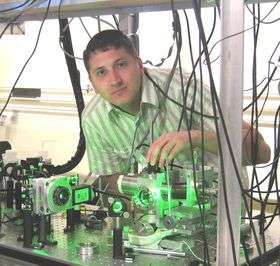December 4, 2007 feature
Proving an aspect of the AB effect: when Newton's Third Law doesn't work

An action doesn’t always result in a reaction.
One of the interesting phenomena present in quantum mechanics is the Aharonov-Bohm (AB) effect. The AB effect predicts that a charged particle, usually an electron in experiments, shows effects from electromagnetic fields in regions where the particle is excluded. This leads to the interesting fact that, in electromagnetism, Newton’s Third Law of Motion doesn’t always hold true.
Herman Batelaan explains to �鶹��ԺOrg.com: “If you want to move anything in the world around you, you need forces. But in the Aharonov-Bohm effect, the electron reacts without any forces. There is no force, but something happens.”
Batelaan, a scientist at the University of Nebraska-Lincoln oversaw an experiment done by graduate student, Adam Caprez, and Brett Barwick to demonstrate the absence of forces in the AB effect. A description of the experiment, and their results, is available in �鶹��Ժical Review Letters: “Macroscopic Test of the Aharonov-Bohm Effect.”
“The interesting thing,” Batelaan says, “is that experimentally scientists have detected evidence of this effect, and it is mentioned in textbooks. But nobody had shown that no forces are there.” The experiment performed at the University of Nebraska-Lincoln constitutes the first demonstration of a lack of forces. “We know the effects, and this is expected.” Batelaan continues. “Theoretically, scientist predicted this, but we want to see this. Now we have it.”
Experimental demonstrations of the AB effect usually include carefully controlled electrons using a distant electromagnetic field. “We understand the physics of this, such that we can take electrons and control them so well that we can see quantum mechanics happening,” Batelaan says. In order to perform the current experiment, the team used a pulse laser to hit a metal needle, a method developed at Stanford.
“You have a pulsed electron source,” Batelaan explains, “and you have something you can time.” Batelaan says that if a force is present there will either be a delay, or an early arrival. The experiment showed no time delay, and this demonstrates that the AB effect lacks forces, even though something is clearly happening with the electrons.
Caprez said that what he found most appealing is that, “we have a rare example where quantum mechanics, electromagnetism and relativity are all working at the same time.”
As far as immediate applications are concerned, Batelaan admits that there isn’t much about this experiment that will be useful on a practical level right now. But, he insists, “This is very fundamental quantum mechanically. It is helpful in terms of a better understanding on the quantum level.” He points out that devices are reducing in size at a rapid pace, and that as science and technology shrink, “we will need to understand the interplay between quantum mechanics and electromagnetic fields as deep as possible.”
Copyright 2007 �鶹��ԺOrg.com.
All rights reserved. This material may not be published, broadcast, rewritten or redistributed in whole or part without the express written permission of �鶹��ԺOrg.com.





















